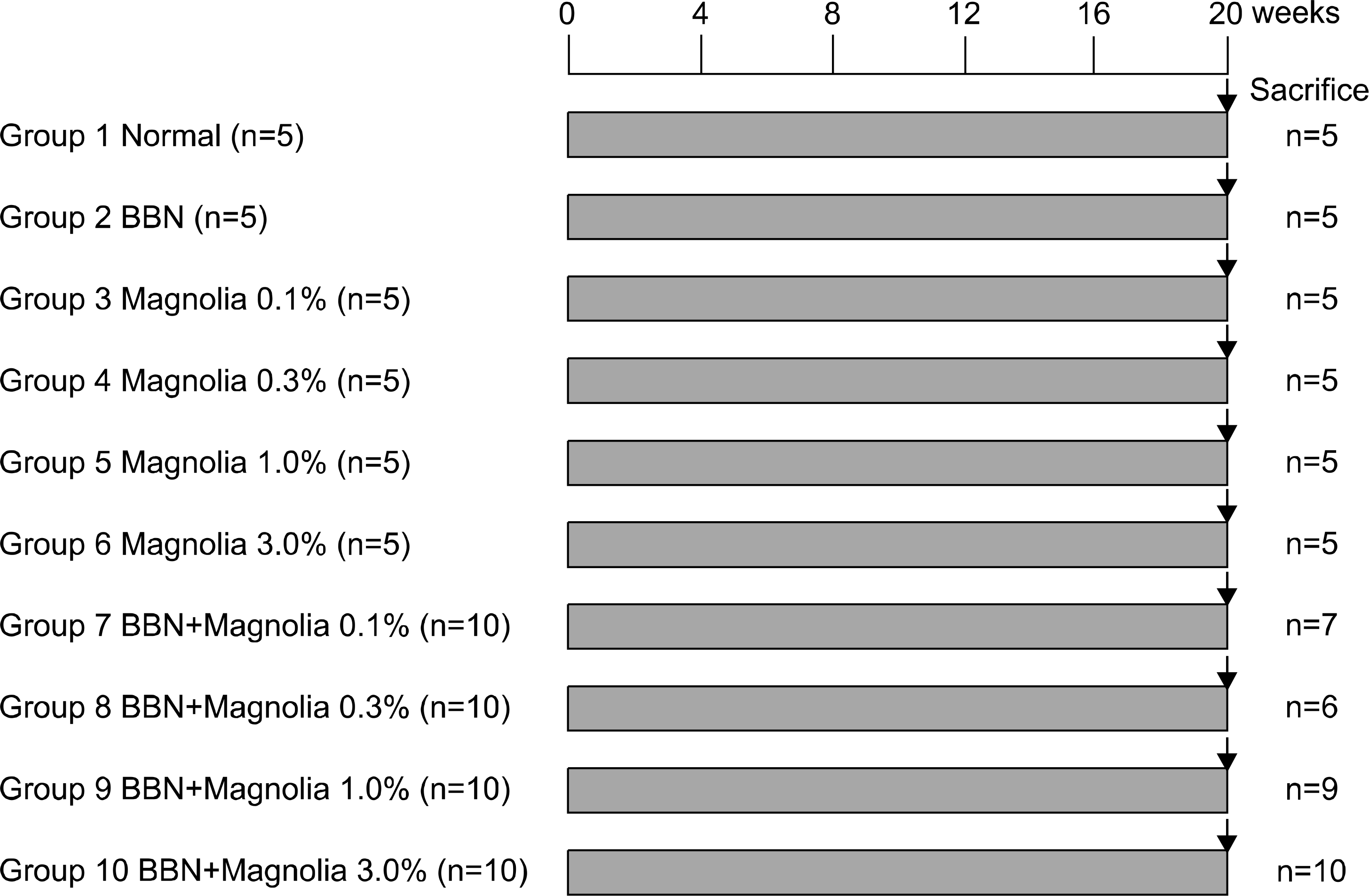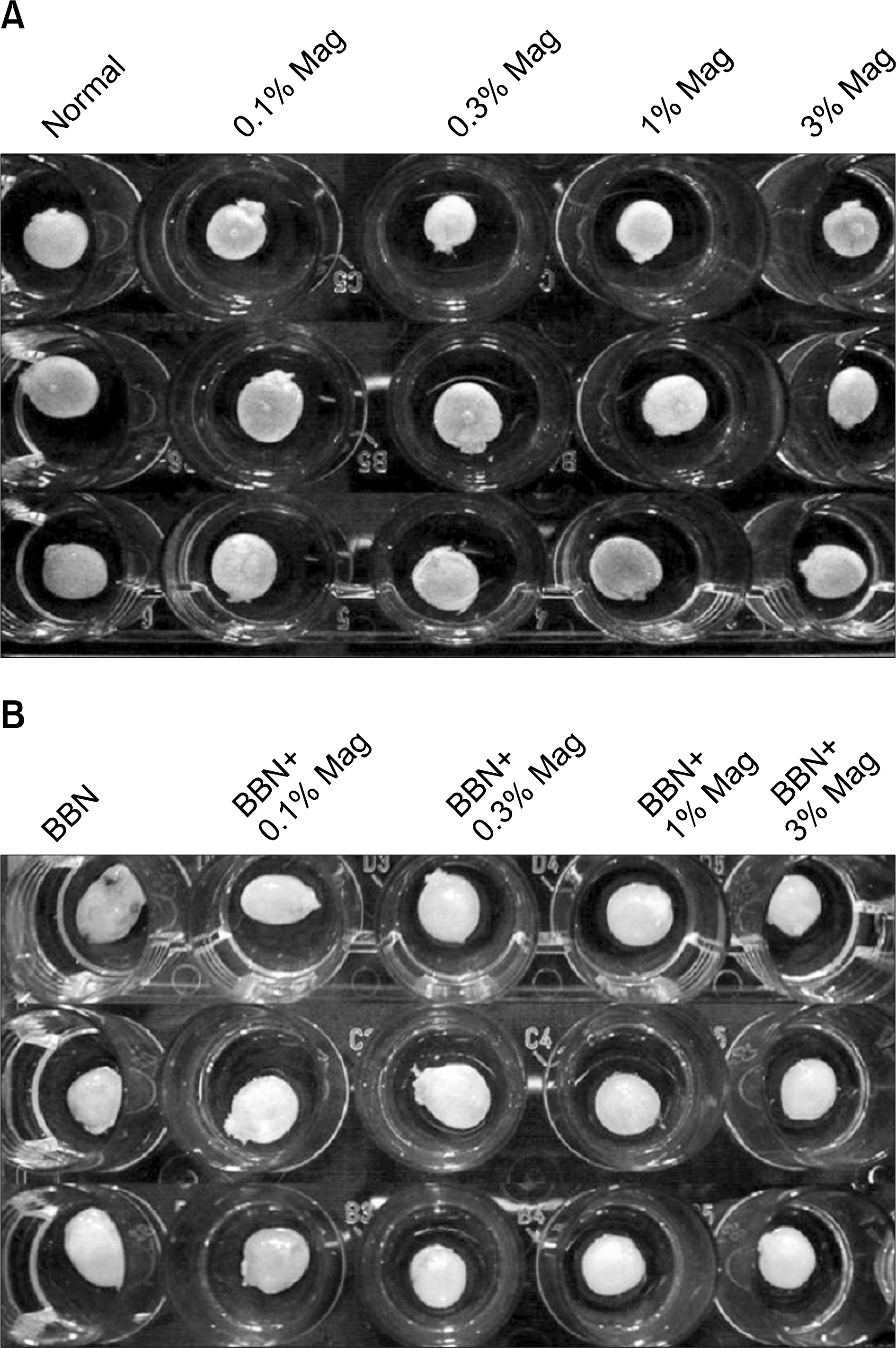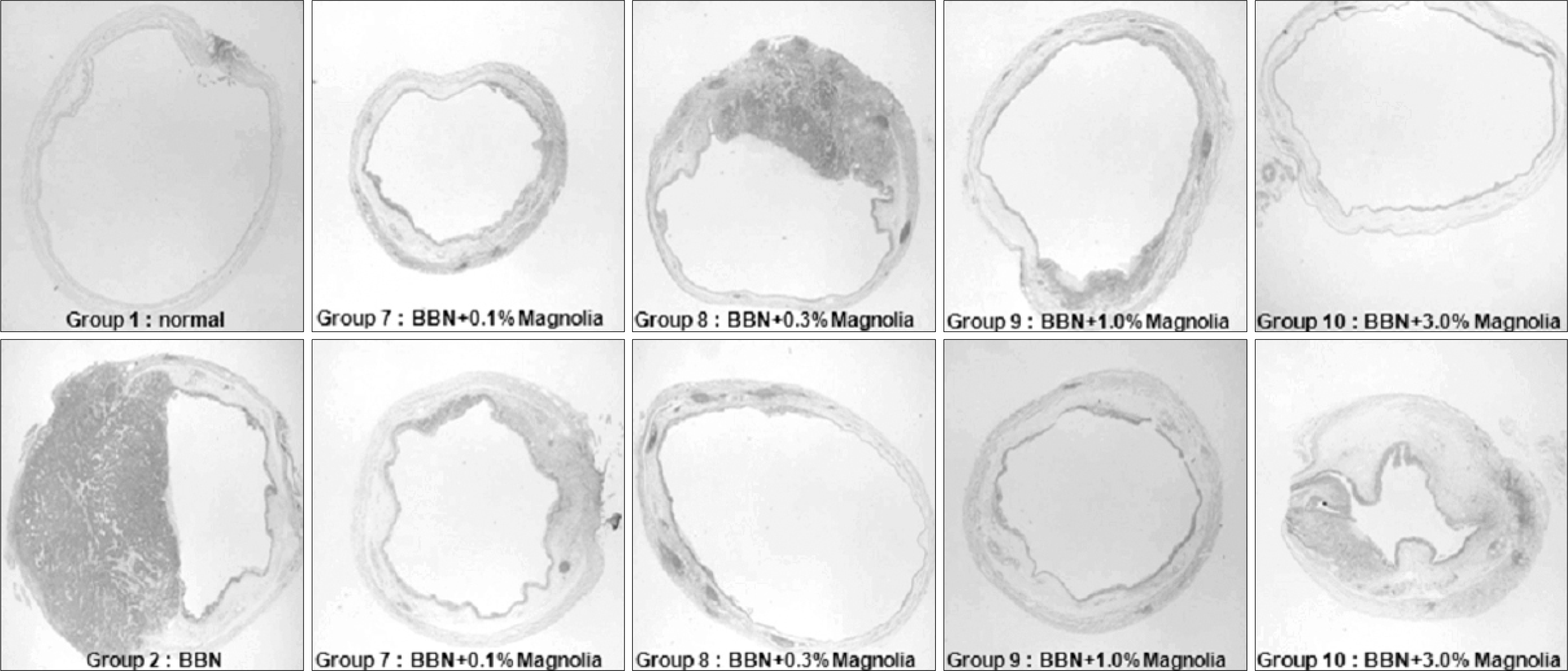Abstract
Purpose
Magnolia officinalis has been used in traditional Chinese medicine to treat a variety of diseases. The main constituents of Magnolia officinalis are honokiol and magnolol, which have a variety of pharmacological effects, such as antitumor, antioxidant, antimicrobial, anti-inflammatory etc. This study examined the anticancer effect of a Magnolia officinalis’ extract on urinary bladder cancer in vivo.
Materials and Methods
Male mice C3H/He were used as the experimental animals. The mice were divided into ten groups. Normal drinking water was provided to group 1 (5 mice) for 20 weeks and 0.05% N-butyl-N-(4-hydroxybutyl) nitrosamine (BBN) was added to in the drinking water of group 2 (5 mice). 0.1, 0.3, 1.0 and 3.0% Magnolia officinalis’ extract was added to groups 3, 4, 5 and 6, respectively (5 mice each), and 0.1, 0.3, 1.0 and 3.0% Magnolia officinalis’ extract plus 0.05% BBN was added to groups 7, 8, 9 and 10, respectively (10 mice each) for the same period. All surviving mice were sacrificed at week 20 to investigate the occurrence of bladder cancer, stage and grade.
Results
Bladder cancer was not observed in groups 1, 3, 4, 5 and 6 mice. The rates of bladder cancer occurrence were 57.1, 66.7, 44.4 and 20.0% in groups 7, 8, 9 and 10, respectively. The incidence decreased with increasing concentration of Magnolia officinalis (p=0.005). However, the stage and grade were not associated with the concentration of Magnolia officinalis (each p>0.05).
REFERENCES
1.Liou KT., Shen YC., Chen CF., Taso CM., Tasi SK. The antiinflammatory effect of honokiol on neutrophils: mechanisms in the inhibition of reactive oxygen species production. Eur J Pharmacol. 2003. 475:19–27.

2.Teng CM., Chen CC., Ko FN., Lee LG., Huang TF., Chen YP, et al. Two antiplatelet agents from Magnolia officinalis. Thromb Res. 1988. 50:757–65.
3.Lo YC., Teng CM., Chen CF., Chen CC., Hong CY. Magnolol and honokiol isolated from Magnolia officinalis protect rat heart mitochondria against lipid peroxidation. Biochem Pharmacol. 1994. 47:549–53.
4.Tse AK., Wan CK., Shen XL., Yang M., Fong WF. Honokiol inhibits TNF-alpha-stimulated NF-kappaB activation and NF-kappaB-regulated gene expression through suppression of IKK activation. Biochem Pharmacol. 2005. 70:1443–57.
5.Fong WF., Tse AK., Poon KH., Wang C. Magnolol and honokiol enhance HL-60 lhuman leukemia cell differentiation induced by 1,25-dihydroxyviamin D3 and retinoic acid. Int J Biochem Cell Biol. 2005. 37:427–41.
6.Wang T., Chen F., Chen Z., Wu YF., Xu XL., Zheng S, et al. Honokiol induces apoptosis through p53-independent pathway in human colorectal cell line RKO. World J Gastroenterol. 2004. 10:2205–8.

7.Park EJ., Zhao YZ., Kim YH., Lee BH., Sohn DH. Honokiol induces apoptosis via cytochrome c release and caspase activation in activated rat hepatic stellate cell in vitro. Planta Med. 2005. 71:82–4.
8.Battle TE., Arbiser J., Frank DA. The natural product honokiol induces caspase-dependent apoptosis in B-cell chronic lymphocytic leukemia (B-CLL) cells. Blood. 2005. 106:690–7.

9.Bai X., Cerimele F., Ushio-Fukai M., Waqas M., Campbell PM., Govindarajan B, et al. Honokiol, a small molecular weight natural product, inhibits angiogenesis in vitro and tumor growth in vivo. J Biol Chem. 2003. 278:35501–7.

10.Druckrey H., Preussman R., Ivanokovic S., Schmidt CH., Mennel HD., Stahl KW. Selective induction of bladder cancer in rats by dibutyl-and-N-butyl-N-butanol(4)-nitrosamine. Z Krebsforsch. 1964. 66:280–90.
11.Kim CS., Park S., Lee SB., Lee JM., Chung H., Chung MK, et al. The use of complementary and alternative medicine in patients with a urological malignancy. Korean J Urol. 2006. 47.

12.Kalman DS., Feldman S., Feldman R., Schwartz HI., Krieger DR., Garrison R. Effect of a proprietary Magnolia and Phellodendron extract on stress levels in healthy women: a pilot, double-blind, placebo-controlled clinical trial. Nutr J. 2008. 7:11.

13.Nagase H., Ikeda K., Sakai Y. Inhibitory effect of magnolol and honokiol from Magnolia obovata on human fibrosarcoma HT-1080. Invasiveness in vitro. Planta Med. 2001. 67:705–8.
14.Kim YK. Bladder cancer: basic research direction. 1st ed.Seoul: Korea Medical Publishing Co;1991. 208-46.
15.Ito N., Makiura S., Yokota Y., Kamamoto Y., Hiasa Y. Effect of unilateral ureter ligation on development of tumors in the urinary system of rats treated with N-butyl-N-(4-hydroxy butyl) nitrosamine. Gann. 1971. 62:359–65.
16.Becci P., Thompson HJ., Strum JM., Brown CC., Sporn MB., Moon RC. N-butyl-N-(4-hydroxybutyl) nitrosamine-induced urinary bladder cancer in C57 BL/6 X DBA/2 F1 mice as a useful model for study of chemoprevention of cancer with retinoids. Cancer Res. 1981. 41:927–32.
Fig. 1.
Experimental protocol for the effect of Magnolia officinalis. BBN: N-butyl-N-(4-hydroxybutyl) nitrosamine.

Fig. 2.
Gross findings of the urinary bladder in the mice. (A) The inflated bladder by formalin in mice treated with normal drinking water or Magnolia officinalis. (B) The inflated bladder by formalin in mice treated with BBN and Magnolia officinalis. BBN: N-butyl-N-(4-hydroxybutyl) nitrosamine.

Fig. 3.
Microscopic findings of BBN induced bladder cancer in the mice. Group 1 (saline) urinary bladder has a normal appearance. Group 2 (BBN) bladder cancer shows a massive infiltrative growth pattern out of the bladder wall. Group 7, 8, 9 and 10 show that the BBN induced bladder cancer decreased with increasing concentration of Magnolia officinalis. BBN: N-butyl-N-(4-hydroxybutyl) nitrosamine.

Table 1.
The stage and grade of the bladder cancers in each group treated with 0.05% BBN and Magnolia officinalis




 PDF
PDF ePub
ePub Citation
Citation Print
Print


 XML Download
XML Download